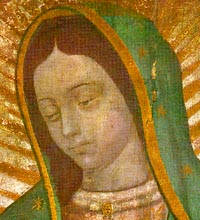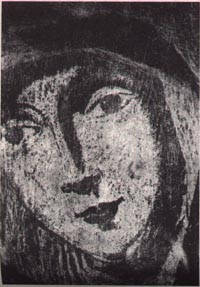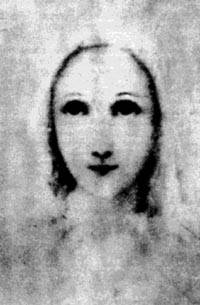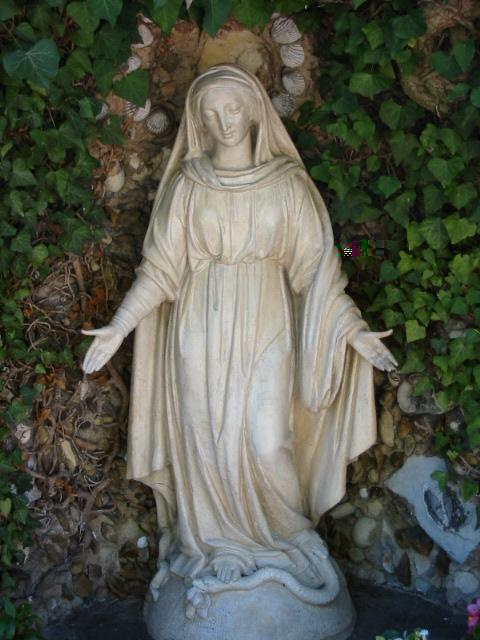





"The bodily shape of the heavenly Queen was well proportioned and taller than is usual with other maidens of her age; yet extremely elegant and perfect in all its parts. Her face was rather more oblong than round, gracious and beautiful, without leanness or grossness; its complexion clear, yet of a slightly brownish hue; her forehead spacious yet symmetrical; her eyebrows perfectly arched; her eyes large and serious, of incredible and ineffable beauty and dovelike sweetness, dark in color with a mixture tending toward green; her nose straight and well shaped; her mouth small, with red-colored lips, neither too thin nor too thick. All the gifts of nature in Her were so symmetrical and beautiful, that no other human being ever had the like." -Description of Our Lady from The Mystical City of God, (Pt II, Bk 3, Ch 2) by Blessed Mary of AgredaSacred Scripture gives us no physical description of the Mother of Jesus Christ. Yet some private revelations have resulted in "miraculous" images of the Blessed Virgin, which may actually reveal her physical features. (May because private revelations are not infallible, and so can be transmitted or interpreted erroneously. Yet ones which the Church approves are safer than those she has not yet recognized.)The Blessed Virgin had auburn hair, dark eyebrows, fine and arched, a very high forehead, large downcast eyes with long, dark lashes, a straight nose, delicate and rather long, a lovely mouth around which played a most noble expression, and a pointed chin. -Description of Our Lady from The Life of Jesus Christ and Biblical Revelations, (Vol. I, page 198) by Anne Catherine Emmerich.
The bishop asked for a sign. On 12 December God performed a miracle to convince the bishop that the apparition had occured. Blessed Mother set Juan Diego to the other side of the hill to collect Castillian roses, which were out of season in December. Yet he found them blooming there, just as Our Lady said! He took them to her in his tilma (cloak), and she proceeded to arrange them with her own hands. She then sent them him to the bishop.
When Juan Diego came before the bishop, he opened his folded cloak, letting the roses fall to the floor. Suddenly, an image of the Blessed Virgin appeared on the tilma, right before the eyes of everyone in the room! The bishop fell to his knees; he was convinced that Mary had appeared to Juan Diego, and the shrine she requested was built on Tepeyac hill.
She called her mother, who also saw the face (which was only about five inches wide and seven long). They concluded that it was the face of the Mother of God. Soon, neighbors came from all around to see the image. It was later moved into the local parish church.
Scientific studies showed that the image had some unusual qualities, which seemed to confirm its supernatural origin. To this day, the miraculously produced face of Our Lady of Absam is displayed on a side altar in the church of Absam, Austria. It is surrounded by ex-voto offerings which testify to the many miracles which God has performed for those who venerate Our Lady of Absam.
This picture of Our Lady was drawn by a mystic in Italy. Her hand was guided by Our Lady. There is a special blessing given each day to the person who carries it and another blessing given each time one looks at it with love.The latter promise of blessings is obviously a private revelation. I would appreciate more information on this picture if anyone has it (since I would have to remove it from this page if it comes from a condemned revelation!)

Also, the two descriptions of Our Lady drawn from private revelations (to Bl, Mary of Agreda and Anne Catherine Emmerich respectively) also bear a striking resemblance to the pictures.
Yet each picture comes from three different countries (Mexico, Austria and Italy respectively). At least the first two were produced more than two centuries apart (1531 and 1797). As for the visionaries, Mary of Agreda lived in Spain during the sixteenth century, and Anna Catherine Emmerich lived in Germany during the 18th and 19th centuries. Yet they all seem to strongly concur!
Now remember, conventional artistic representations of Mary have never been perfectly "uniform. She has in fact been portrayed with many different faces by different artists! So we cannot argue that the similarities in these images arise from a "consensus" among Catholics as to Mary's physical features. Yet the fact that these three images, produced in three different media (paint, glass etching, sketch) in three separate countries over the course of centuries all bear a striking resemblance to one another.
Coincidence? You decide!
This statue of Our Lady of the Waters is on the grounds of the monastery where St. Bernadette lived. She loved this statue and remarked that it reminded her the most of Our Lady of Lourdes.
Note the striking similarity in facial features to the above three images! Could this be further confirmation that Our Heavenly Mother truly looks like this?
| Site Index | Home Page |